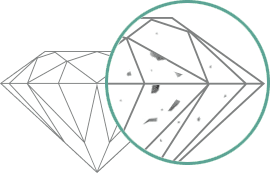
SI Diamond Clarity Meaning
SI clarity diamonds are gemstones that contain noticeable inclusions under 10x magnification, with some inclusions potentially visible to the naked eye. On the GIA clarity scale, SI ranks between Very Slightly Included (VS) and Included (I) grades, representing diamonds with more significant internal characteristics than VS stones, but better clarity than I-grade diamonds.
SI1 Diamond Clarity Meaning
SI1 represents the higher quality grade within the SI category. These diamonds have inclusions that are easily noticeable under 10x magnification but are typically difficult to see with the naked eye. The inclusions in SI1 diamonds are fewer in number, smaller in size, or positioned in less visible locations compared to SI2 stones.
SI2 Diamond Clarity Meaning
SI2 diamonds contain more obvious inclusions that are readily visible under magnification and may be noticeable to the unaided eye. These stones feature inclusions that are larger, more numerous, or located in more prominent positions within the diamond. However, when properly positioned in jewelry settings, many SI2 inclusions can be masked.
SI Diamond Clarity Quality
The quality of SI diamonds varies significantly based on the specific characteristics of their inclusions. Professional gemologists evaluate these stones using five key factors: size, number, location, relief, and nature of the inclusions.
SI1 Diamond Clarity Quality
SI1 diamonds typically offer excellent value for quality-conscious buyers. These stones usually appear eye-clean, meaning their inclusions are not visible without magnification. The placement of inclusions in SI1 diamonds tends to be less central, and the characteristics themselves are often less severe in terms of their impact on the diamond's durability and appearance.
SI2 Diamond Clarity Quality
SI2 diamonds represent a more noticeable step down in clarity quality. While still maintaining structural integrity, these stones often have inclusions that may be visible to the naked eye, particularly in larger diamonds or certain cuts. However, strategic placement in settings can often mask these characteristics effectively.

SI Diamond Clarity Price
SI clarity diamonds typically cost less than VS stones of comparable carat weight, color, and cut. This price difference makes them an attractive option for budget-conscious buyers seeking larger stones.
SI1 Diamond Clarity Price
SI1 diamonds command a premium within the SI category, typically costing more than comparable SI2 stones. This price difference reflects their superior clarity characteristics and greater likelihood of appearing eye-clean.
SI2 Diamond Clarity Price
SI2 diamonds offer significant value, often costing less than VS2 stones of similar specifications. This substantial price reduction makes them popular choices for buyers prioritizing carat weight over perfect clarity.

SI1 vs. SI2 Diamond Clarity
The main difference between SI1 and SI2 diamonds lies in their inclusions. SI1 diamonds have fewer and less noticeable inclusions, while SI2 diamonds contain more visible characteristics under magnification. This distinction becomes crucial when selecting a diamond, as size and cut style significantly impact how these inclusions appear to the naked eye.
For diamonds under 1 carat, especially in round brilliant cuts, a well-chosen SI2 can provide excellent value while maintaining an attractive appearance as the faceting pattern helps mask inclusions. However, for stones over 1 carat or in step cuts like emerald and Asscher, SI1 clarity offers a better investment despite its 10-15% premium, as inclusions become more visible in larger stones. While individual evaluation is essential, SI1 generally provides an optimal balance of quality and value for larger diamonds.









